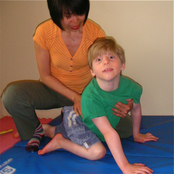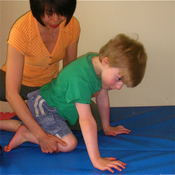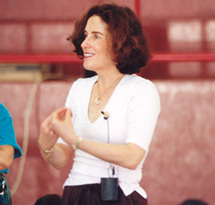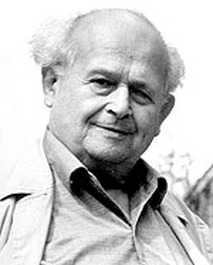Pause for a moment and watch what
Healthy babies do!
They keep trying over and over again, repeating similar and apparently silly actions, undefeated by failures or so called ‘mistakes’ and then they finally hit the ball or reach for that toy.
Learning to grasp takes a much longer experimentation with the added complexity of figuring out how to work the fingers, and putting a finger into the mouth calls for a lot of approximation.
Neither you or I can remember how we learned to do it, but we did!
“Learning How To Learn”



A simple intentional action comes about with a lot of apprenticeship that only the trained eye can discern. For the infant, it’s the taste of success, the gratification of the sensation of the finger in the mouth, the toy in the hand and the smile on their face! Through this process of ‘trial and error’, children gradually develop movements that fulfill their purpose. Every success fuels the strive/drive for more successes. In time, children learn the process of ‘learning how to learn’.
Can a child learn to ‘fail’ too? Should it really be called ‘failing’? If a child repeats actions only to discover that it is not what he intends, then he learns too. If we place an infant on her tummy before she’s developed the necessary muscular control to lift her head up, how would that feel? Look at the infant’s face and one can see that of discomfort.
How about propping your child up to teach sitting balance before he has developed the necessary muscular control to do so? How is he going to support himself? The demand on the nervous system is so high your child would have no choice but to stiffen up the whole body in an attempt to avoid falling over. What is your child learning?
When we challenge our children to attempt actions far beyond their abilities, we are essentially teaching them to ‘fail’. And repeating these actions over time, your child learns to fail over and over again which could unintentionally stifle their very desire to move, learn and evolve. Isn’t it interesting and challenging too?
Learning to Succeed!
What if we teach our children to succeed by giving them incremental challenges they can easily overcome and in the process experience a sense of achievement?
Will our children be more likely to attempt repeated actions that would eventually overcome far greater challenges? The answer is most definitely ‘YES’!
How can this be achieved?
How can we help your child with special needs realize that movement can be easy? And that continuous and guided learning and movement can be real fun?

 The Anat Baniel Method® (ABM) Neuromovement® is derived from the Feldenkrais Method®. It is based primarily on the understanding of what the brain requires in order to form new patterns and configurations of action. It is not a medical approach but rather a learning based approach. It does not focus on the limitations of the child but rather on what the child can do.
The Anat Baniel Method® (ABM) Neuromovement® is derived from the Feldenkrais Method®. It is based primarily on the understanding of what the brain requires in order to form new patterns and configurations of action. It is not a medical approach but rather a learning based approach. It does not focus on the limitations of the child but rather on what the child can do.
No matter what the condition of the child, it looks to communicate with the child and the child’s brain to help it form new movement patterns that will help the child get past his/her own limitations.
Read more about the Anat Baniel Method® Neuromovement®.
 Developed by Moshe Feldenkrais, D.Sc. (1904-1984) in the late 1940s, the Feldenkrais Method® helps us reconnect with our natural ability to move, using an exploratory process of learning that we see in children.
Developed by Moshe Feldenkrais, D.Sc. (1904-1984) in the late 1940s, the Feldenkrais Method® helps us reconnect with our natural ability to move, using an exploratory process of learning that we see in children.
In the Feldenkrais Method®, each person already presents their ideal body, their ideal way to move. This might be a difficult concept to grasp, yet everyone makes their best choice given his or her perception of available choices.
The Feldenkrais Method® works by creating new sensory and movement patterns based on the existing ones. Change is possible once you are aware of how you use your body, and when you are given the means to make better choices and to act on them. By building upon what you actually do, rather than what you “should do”, the improvement happens organically, from the inside.
The Feldenkrais Method® invokes a sense of somatic wholeness while developing the capacity for learning without goals, comparison to others, or external standards.
Read more about the Feldenkrais Method®.
Application for Children with Special Needs
Both the Anat Baniel Method® Neuromovement® and Feldenkrais Method® powerfully and consistently create progress for children affected by cerebral palsy, stroke, brain injuries, torticollis, brachial plexus injury, scoliosis, Down’s syndrome and other genetic disorders, autism, autistic spectrum disorders and a host of other conditions.
Whatever your child’s condition, both the Feldenkrais Method® and Anat Baniel Method® Neuromovement® can help provide your child with the opportunity to feel the joy of discovering a new “best”.
What Parents Say About the Methods
After a lesson, parents have reported that among the first changes they see in their child are:
- Increased attention & ability to focus
- Increased alertness
- Greater comfort
- Improved mood
- Better sleep
Functional changes that have occurred
After a lesson, parents have reported that these functional changes have occurred:
- Improved ability to move
- Increased ease & repertoires of movement
- Improved balance
- Greater problem-solving skills
- Improved speech
Interested in learning more about the therapy?
Download this brochure for more information.
